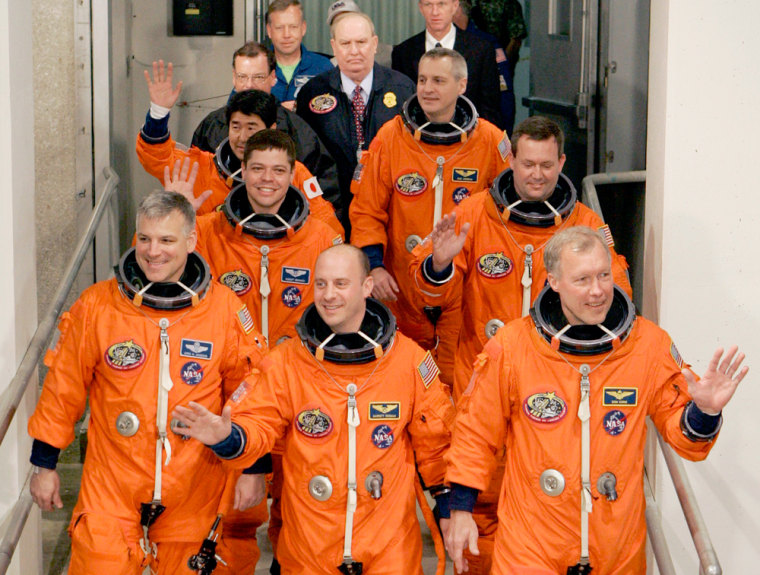The shuttle Endeavour and its crew of seven blasted off Tuesday on what was to be the longest space station visit ever, a 16-day voyage to build a gangly robot and add a new room that will serve as a closet for Japan’s future lab.
The space shuttle roared from its seaside pad at 2:28 a.m. ET, lighting up the sky for miles around.
It was a rare treat: The last time NASA launched a shuttle at night was in 2006. Only about a quarter of shuttle flights have begun in darkness.
“Good luck and Godspeed, and we’ll see you back here in 16 days,” launch director Mike Leinbach radioed to the astronauts right before liftoff.
“We’d like to say konnichiwa, domo arigato and banzai,” replied shuttle commander Dominic Gorie, using greetings from Japan in a nod to that country’s contribution to Endeavour's mission. “God truly has blessed us with a beautiful night here, Mike, to launch, so let’s light them up and give Him a show.”
They did. The shuttle took flight with a flash of light, giving a peach-yellow glow to the low clouds just offshore before disappearing into the darkness.
Longest shuttle visit to station
Endeavour's mission is scheduled to be the longest shuttle flight since space station assembly began in 1998, and the sixth-longest shuttle mission ever. Gorie and his crew will face a daunting job once they reach the international space station late Wednesday night. The astronauts will perform five spacewalks, the most ever planned during a shuttle visit.
The launch site was jammed with Canadians and Japanese representing two of the major partners in the international space station. The Canadian Space Agency supplied Dextre, the two-armed robot that was hitching a ride aboard Endeavour, while the Japan Aerospace Exploration Agency sent up the first part of its massive Kibo lab, a storage compartment for experiments, tools and spare parts.
Also on hand for the liftoff was a 19-member congressional delegation led by Rep. Nick Lampson, D-Texas, whose district includes Johnson Space Center in Houston. He is pushing for increased NASA funding.
A piece of the action
For the first time since space station construction began nearly 10 years ago, all five major partners — the United States, Russia, Europe, Canada and Japan — will each own a piece of the orbiting real estate. The launch of the first section of Kibo, or Hope, finally propelled Japan into the space station action.
“Our Japanese people have been waiting for a very long, long time,” said Yoshiyuki Hasegawa, the Japanese Space Agency’s station program manager.
Preliminary design work for Kibo (pronounced KEE-boh) began in 1990. Space station construction, however, was stalled over the years for various reasons, most recently the 2003 Columbia tragedy.

The main part of the Kibo lab will fly on the next shuttle mission in May, with the final installment, a porch for outdoor experiments, going up next year.
Altogether, the Japanese Space Agency has invested about $6.7 billion in the space station program, including a Kibo control center near Tokyo.
Canada’s $200 million-plus Dextre, meanwhile, is designed to eventually take over some of the more routine outdoor maintenance chores from spacewalking astronauts. Dextre, short for dexterous and pronounced like Dexter, will join the space station’s Canadian-built robot arm, already in orbit for seven years.
Testing goo, swapping crew
In addition to working with their international payloads, Endeavour’s astronauts will try out a caulking gun and high-tech goo on deliberately damaged shuttle thermal tile samples. The test — part of NASA’s ongoing post-Columbia safety effort — should have been performed last year, but was put off because of emergency space station repairs.
Astronaut Garrett Reisman will stay behind on the space station until June, swapping places with a Frenchman who accompanied Europe’s Columbus lab into orbit in February.
A Japanese astronaut, Takao Doi, is also part of Endeavour’s all-male crew. Among other space station duties, Doi is due to test a new line of anti-bacterial, anti-static boxer shorts and gymwear.
Endeavour’s countdown was the smoothest in years, officials said. Shortly after liftoff, however, the astronauts had to deal with a couple of problems that ended up being minor. They got alert messages for some of their ship’s steering thrusters, but it turned out to be a bad electronics card. Then the primary cooling system failed, and they had to switch to the backup.
A cursory look at the initial launch images — fewer than usual because of the nighttime launch — showed only one significant loss of debris from the external fuel tank 83 seconds into the flight. But it appeared to miss the right wing.
In any event, Endeavour will be checked thoroughly in orbit for any potential damage, standard procedure ever since the loss of Columbia because of a foam strike.
“This is just a wonderful beginning to what’s going to be a long and challenging mission for us,” said LeRoy Cain, a shuttle manager who gave the final “go” for launch. “But we’re really looking forward to it and we’re ready to go, ready to get to work on orbit.”
Endeavour's flight is the second of six planned shuttle missions this year — with five going to the space station and one going to the Hubble Space Telescope for a final service call.
NASA faces a 2010 deadline for finishing the station and retiring its shuttles.
This report was supplemented with information from Reuters and msnbc.com.